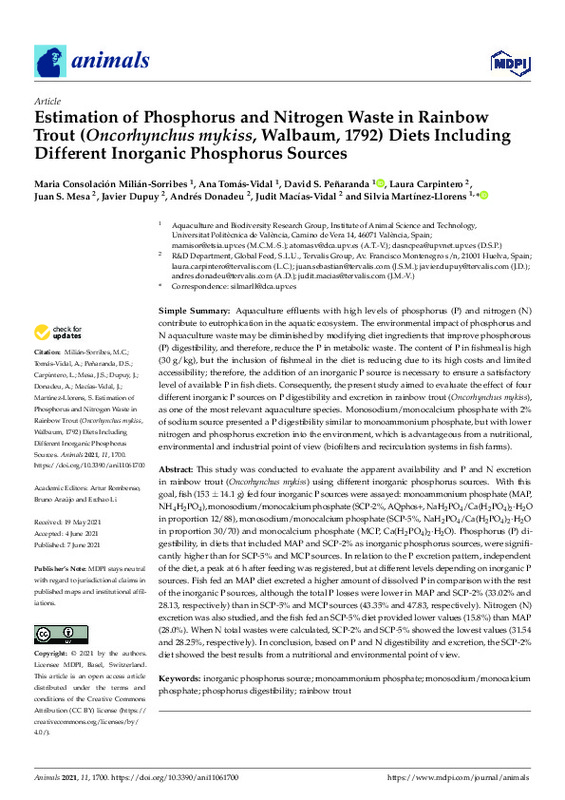|
Resumen:
|
[EN] Aquaculture effluents with high levels of phosphorus (P) and nitrogen (N) contribute to eutrophication in the aquatic ecosystem. The environmental impact of phosphorus and N aquaculture waste may be diminished by ...[+]
[EN] Aquaculture effluents with high levels of phosphorus (P) and nitrogen (N) contribute to eutrophication in the aquatic ecosystem. The environmental impact of phosphorus and N aquaculture waste may be diminished by modifying diet ingredients that improve phosphorous (P) digestibility, and therefore, reduce the P in metabolic waste. The content of P in fishmeal is high (30 g/kg), but the inclusion of fishmeal in the diet is reducing due to its high costs and limited accessibility; therefore, the addition of an inorganic P source is necessary to ensure a satisfactory level of available P in fish diets. Consequently, the present study aimed to evaluate the effect of four different inorganic P sources on P digestibility and excretion in rainbow trout (Oncorhynchus mykiss), as one of the most relevant aquaculture species. Monosodium/monocalcium phosphate with 2% of sodium source presented a P digestibility similar to monoammonium phosphate, but with lower nitrogen and phosphorus excretion into the environment, which is advantageous from a nutritional, environmental and industrial point of view (biofilters and recirculation systems in fish farms). This study was conducted to evaluate the apparent availability and P and N excretion in rainbow trout (Oncorhynchus mykiss) using different inorganic phosphorus sources. With this goal, fish (153 +/- 14.1 g) fed four inorganic P sources were assayed: monoammonium phosphate (MAP, NH4H2PO4), monosodium/monocalcium phosphate (SCP-2%, AQphos+, NaH2PO4/Ca(H2PO4)(2)center dot H2O in proportion 12/88), monosodium/monocalcium phosphate (SCP-5%, NaH2PO4/Ca(H2PO4)(2)center dot H2O in proportion 30/70) and monocalcium phosphate (MCP, Ca(H2PO4)(2)center dot H2O). Phosphorus (P) digestibility, in diets that included MAP and SCP-2% as inorganic phosphorus sources, were significantly higher than for SCP-5% and MCP sources. In relation to the P excretion pattern, independent of the diet, a peak at 6 h after feeding was registered, but at different levels depending on inorganic P sources. Fish fed an MAP diet excreted a higher amount of dissolved P in comparison with the rest of the inorganic P sources, although the total P losses were lower in MAP and SCP-2% (33.02% and 28.13, respectively) than in SCP-5% and MCP sources (43.35% and 47.83, respectively). Nitrogen (N) excretion was also studied, and the fish fed an SCP-5% diet provided lower values (15.8%) than MAP (28.0%). When N total wastes were calculated, SCP-2% and SCP-5% showed the lowest values (31.54 and 28.25%, respectively). In conclusion, based on P and N digestibility and excretion, the SCP-2% diet showed the best results from a nutritional and environmental point of view.
[-]
|
|
Agradecimientos:
|
This study has been developed under the framework of the project entitled "Improvement of the nutritional quality of aquaculture feeds through the incorporation of microalgae hydrolysates enriched in probiotic microorgan ...[+]
This study has been developed under the framework of the project entitled "Improvement of the nutritional quality of aquaculture feeds through the incorporation of microalgae hydrolysates enriched in probiotic microorganisms-ALQUABIOTIC," ITC-20181099, corresponding to the FEDER INNTERCONECTA 2018 call, funded by CDTI (Centre for the Development of Industrial Technology), supported by the Ministry of Science, Innovation and Universities and co-financed by FEDER funds (European Regional Development Fund) within the 2014-2020 Intelligent Growth Operational Program.
[-]
|









